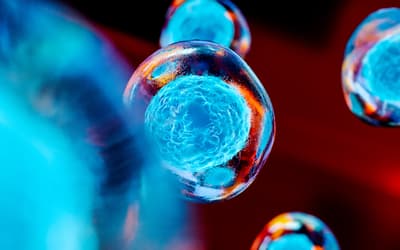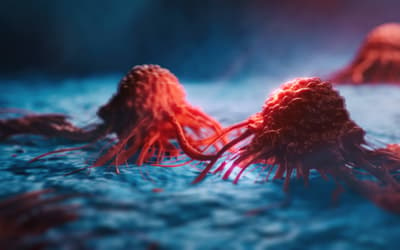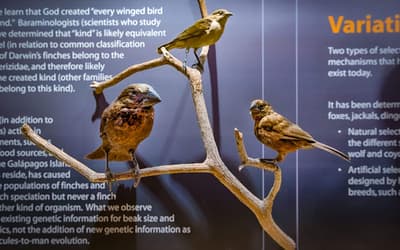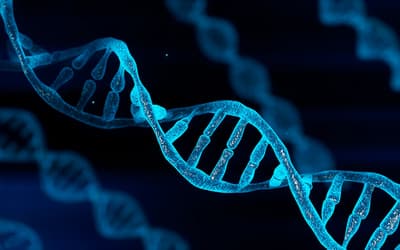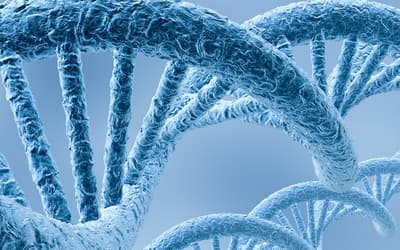The views expressed in this paper are those of the writer(s) and are not necessarily those of the ARJ Editor or Answers in Genesis.
Abstract
HIV-1 uses the CD4 molecule as its receptor and a chemokine receptor as a coreceptor, to recognize a host cell. Most strains use CCR5 as their coreceptor during the initial stages of infection. Frequently, the virus will evolve within the host to expand coreceptor usage to include CXCR4. The new protein-protein interaction between the viral glycoprotein, gp120, and cellular CXCR4 enables the virus to infect more T helper cells. The innovative power of mutation and selection demonstrated in the coreceptor switch of HIV-1 challenges our understanding of “the edge of evolution.” Here I argue that this new molecular interaction is no more than a cyclic fine-tuning of an existing function. Most importantly, switching from CCR5 to CXCR4 usage compromises transmissibility of HIV-1, kills its host sooner, so ultimately is a disadvantage to the virus on the ecological level. Rather than being an example of evolutionary creativity, it illustrates the broken relationship between the virus and the host through mutation of the viral genome.
Introduction
In his book, The Edge of Evolution, Michael Behe used the human immunodeficiency virus type 1 (HIV-1) to illustrate the limits of Darwinian evolution (Behe 2007). Even though the virus “mutates at the evolutionary speed limit,” it essentially remains the same—even given what is equivalent to deep evolutionary time.
Recently, Carter and Sanford reported the opposite of progressive evolution—decay and extinction—in the H1N1 influenza virus (Carter and Sanford 2012). When the mutation rate of an influenza virus exceeds the limits of purifying selection, the viral lineage must lose vitality and eventually disappear from the human population. Since HIV-1, the causative agent of pandemic AIDS, has been circulating for decades, we can likewise ask—is it evolving or devolving? This is the first in a series of articles intended to review recent literature on HIV-1 evolution. The goal is to gain insight into the future of this devastating virus. This first article will address a major adaptation which is observed in HIV-1 illustrating the creative power of random mutation and natural selection, i.e., the cyclic selection of host cell tropism.
Evolution of a New Protein—Protein Interaction
HIV-1 mainly infects two kinds of human cells: T helper cells and macrophages. As the first step in the infectious process, the virus uses its gp120 protein to bind to a CD4 molecule on the surface of a T helper cell or a macrophage. However, in order for the virus to penetrate into the cell, the viral gp120 must also bind another molecule on the cell surface, called a coreceptor. There are two major kinds of coreceptors, CCR5 or CXCR4. These coreceptors, like CD4, are normally used by the cell to recognize signals of communication within the human body, and the virus can exploit these. Both CCR5 and CXCR4 belong to a protein family called G protein-coupled chemokine receptors. They have similar structures—a chain of amino acids anchored on the cell membrane by crossing it seven times. CCR5 is located in the membranes of macrophages and memory T helper cells, while CXCR4 is more abundant on another subset of T cells called naïve T helper cells. When a typical HIV-1 virus enters a person, it first uses CCR5 as the coreceptor to infect macrophages and memory T cells. This kind of virus is called an R5- or M-tropic (for macrophage) virus. The ability to infect macrophages is essential for establishing infection in the mucous membranes, as found in the genital tract. After the memory T cells are infected and mostly destroyed by the virus, it would be advantageous to the virus to infect more T helper cells, those that carry CXCR4 coreceptors. In about 50% of cases, some R5-tropic viruses (especially subtype B) would evolve into X4-tropic viruses, which can use CXCR4 as the coreceptor instead of CCR5. Emergence of X4-tropic viruses is associated with rapid depletion of the host’s T helper cells and exacerbation of AIDS. However, upon transmission into a new host, it is the R5-tropic virus, not the X4-tropic virus, that founders a new infection, and the cycle starts again (McGowan and Shah 2010).
Here we see the repeated creation of a new protein-protein interaction due to evolution of HIV-1 within the host (intrahost evolution). Protein-protein interactions are fundamental biochemical processes in every aspect of life: gene regulation, protein synthesis, intracellular transport, movement, cell-cell communication, etc. Binding CXCR4 enables HIV-1 to expand its host cell range and changes the course of the war of attrition between the virus and the host, in favor of the virus. Since the recognition between gp120 and CXCR4 involves biological information, it apparently challenges the concept of conservation of information, as proposed by Dembski (2001). However, the question boils down to: how new is this new interaction?
Molecular Basis of the New Interaction
The gp120 protein is encoded by the env gene of HIV and contains five hypervariable domains (V1–V5) interspersed with conserved regions. While gp120 interacts with CD4 using a conserved region, it interacts with the coreceptors using its hypervariable domains (Kwong et al. 1998; McGowan and Shah 2010). Diversification in the variable domains seems to be driven by immune responses of the host. Mutations in the V regions, especially the V3 loop, eventually alter the affinity of gp120 for coreceptors. One of the known factors affecting coreceptor use is the net charge of amino acid residues in V3. If the net charge in the loop is 4 or below, the virus binds CCR5. On the other hand, if the net charge in the loop is 5 or above, the virus tends to use CXCR4. In other words, replacement of acidic or neutral amino acids in the V3 loop (especially at certain specific positions) by basic amino acids turns an R5-tropic virus to X4-tropism (Poveda et al. 2010).
During the process of switching from R5- to X4-tropism, some viral isolates may exhibit dual tropism. In fact, one isolate was reported to use CXCR4, CCR3, CCR5, and CCR2b as coreceptors (Hu et al. 2000). Specificity for CCR5 is gradually lost as gp120 gains affinity for CXCR4. There are also strains of HIV using other structurally related coreceptors on CD4+ cells, depending on availability (Hoffman et al. 1998). Since the structures of CCR5 and CXCR4 are very similar (Berson and Doms 1998), it seems that the same site of gp120 can be fine-tuned by mutation and selection to bind similar yet distinct coreceptors in order to infect a changing repertoire of host cells.
Several points are noteworthy. First, this is not de novo creation of a new interaction. There is no creation of a new gene, but alteration of an existing gene, involving only a few small-scale mutations. Gain of CXCR4 tropism is achieved at the cost of CCR5 affinity. Second, there is still a limit to the creative power of mutation and selection. It is always evolving from R5-tropism to X4-tropism. Even though usage of other coreceptors may appear, they are all similar chemokine receptors. This is akin to an enzyme fine-tuning its ability to bind available substrates. Some proteins contain hypervariable regions that are designed to mutate in order to maximize interactions with other molecules. Third, the change is cyclic in nature. X4-tropism is generally not transmissible between hosts. Every new infection returns to the original R5-tropism.
The Advantages of Not Evolving
The ability to evolve from R5- to X4-tropism obviously enhances the replicative capacity of HIV-1 within the host. Expansion of coreceptor tropism increases productivity of the virus, as shown by the increase in viral load in the patient’s blood (McGowan and Shah 2010). It also provides a way to resist antiviral therapy. There is an antiviral drug, Maraviroc, which is designed to block the CCR5 coreceptor. Treatment with Maraviroc fails when the virus evolves X4-tropism.
On the ecological level, however, the ability to evolve X4-tropism is more of a hindrance than a selective advantage for the virus. This is evidenced by the fact that HIV-1 subtype C, which is more likely to stay R5-tropic throughout the course of infection, is on the rise globally (Ariën, Vanham, and Arts 2007; Jakobson et al. 2013). In some areas, it is replacing other subtypes (Ariën, Vanham, and Arts 2007). The underlying mechanisms are not clear, but one report points to its increased ability to infect CCR5-bearing cells, which is critical in establishing new infections (Sundaravaradan et al. 2007). Since the reproductive mucosa is rich in CCR5-bearing cells, R5-tropic HIV subtype C has been found to outcompete subtype A in the female reproductive tract, thus increasing its chances of heterosexual transmission (Walter et al. 2009). Apparently, moving away from R5-tropism compromises transmissibility of HIV-1.
It is tempting to speculate that the ability to evolve from R5- to X4-tropism is designed and the loss of this adaptability in subtype C is a result of mutational degeneration. However, it is ultimately not advantageous for the virus to switch coreceptors and to infect as many host cells as possible. From a creationist perspective, retroviruses were not created to destroy their hosts (Liu 2006). Indeed, most simian immunodeficiency viruses (SIVs), which are generally believed to be precursors of HIVs, do not use CXCR4 as coreceptors, and are nonpathogenic in their natural hosts (Sina, Ren, and Cheng-Mayer 2010). One of the reasons that HIVs cause AIDS is destruction of the thymus. Since developing T cells in the thymus predominantly express CXCR4 rather than CCR5, X4-tropic viruses contribute to AIDS development by depleting the source of T cells in the thymus (Nunes-Cabaço et al. 2015). By maintaining R5-tropism and sparing the naïve and developing T helper cells of the host, subtype C of HIV-1 is associated with slower disease progression, and therefore increased chances to infect new hosts (Ariën, Vanham, and Arts 2007). The ability of subtype C to stay R5-tropic may have to do with the conformation of the V3 loop, making it more constrained, and mutating into X4-tropism incurs a severe fitness cost (Patel, Hoffman, and Swanstrom 2008).
Tropism switch is accompanied by genetic degeneration. Comparison of the V3 regions of R5- and X4-tropic viruses reveals that X4-tropic viruses show more variation in the V3 region and a higher entropy level in almost every amino acid position (Coetzer et al. 2006; McGowan and Shah 2010; Shiino et al. 2000). In subtype B, non-switching strains are able to keep increasing N-glycosylation sites in the V1-V3 region in order to shield the virus from host antibodies, while the switching strains fail to do so (Mild et al. 2010). These indicate that tropism switch is part of an overall degenerative process. It happens late during HIV-1 infection when selective pressure from host immunity relaxes.
Conclusion
HIV-1 routinely switches coreceptors during its progression within a given host individual. The switch is based on fine-tuning of a variable region of the viral gp120—so it can bind to an alternative coreceptor. The mutations that allow the switch are not particularly specific—they only need to accomplish a change in net charge in the relevant region of the gp120 protein. This is a good example of adaptation arising by fine-tuning (micro-evolution). Like most instances of micro-evolution, there is a downside—the virus loses transmissibility.
Coreceptor switch of HIV-1 illustrates the shortsightedness of the Darwinian mechanism. In the short run, viruses that are able to expand their host cell range will produce more progeny within the host, but in the long run, evolution away from the original R5-tropism kills the host sooner, and compromises transmissibility of the virus between hosts, negatively affecting the competitiveness of the viral lineage on the ecological level. Tropism switch of HIV-1 provides no challenge to “the edge of evolution” and is in conformity with the concept of genetic entropy.
References
Ariën, K.K., G. Vanham, and E.J. Arts. 2007. Is HIV-1 evolving into a less virulent form in humans? Nature Reviews Microbiology 5, no.2:141–151.
Behe, M.J. 2007. The edge of evolution: The search for the limits of Darwinism. New York, New York: Free Press.
Berson, J.F., and R.W. Doms. 1998. Structure-function studies of the HIV-1 coreceptors. Seminars in Immunology 10, no.3:237–248.
Carter, R.W., and J.C. Sanford. 2012. A new look at an old virus: Patterns of mutation accumulation in the human H1N1 influenza virus since 1918. Theoretical Biology and Medical Modeling 9:42.
Coetzer, M., T. Cilliers, L.H. Ping, R. Swanstrom, and L. Morris. 2006. Genetic characteristics of the V3 region associated with CXCR4 usage in HIV-1 subtype C isolates. Virology 356, no.1–2:95–105.
Dembski, W.A. 2001. No free lunch: Why specified complexity cannot be purchased without intelligence. Lanham, Maryland: Rowman & Littlefield Publishers.
Hoffman, T.L., E.B. Stephens, O. Narayan, and R.W. Doms. 1998. HIV type I envelope determinants for use of the CCR2b, CCR3, STRL33, and APJ coreceptors. Proceedings of the National Academy of Sciences U.S.A. 95, no.19:11360– 11365.
Hu, Q.X., A.P. Barry, Z.X. Wang, S.M. Connolly, S.C. Peiper, and M.L. Greenberg. 2000. Evolution of the human immunodeficiency virus type 1 envelope during infection reveals molecular corollaries of specificity for coreceptor utilization and AIDS pathogenesis. Journal of Virology 74, no.24:11858–11872.
Jakobsen, M.R., K. Cashin, M. Roche, J. Sterjovski, A. Ellett, K. Borm, J. Flynn, et al. 2013. Longitudinal analysis of CCR5 and CXCR4 usage in a cohort of antiretroviral therapy-naïve subjects with progressive HIV-1 subtype C infection. PLoS One 8, no.6:e65950.
Kwong, P.D., R. Wyatt, J. Robinson, R.W. Sweet, J. Sodroski, and W.A. Hendrickson. 1998. Structure of an HIV gp120 envelope glycoprotein in complex with the CD4 receptor and a neutralizing human antibody. Nature 393:648–659.
Liu, Y. 2006. Were retroviruses created good? Answers in Depth, volume 1 (2006). https://www.answersingenesis.org/biology/microbiology/were-retroviruses-created-good/.
McGowan, J.P., and S. Shah. 2010, Understanding HIV tropism. The PRN Notebook 15. http://www.prn.org/index.php/management/article/hiv_tropism_1002.
Mild M., A. Kvist, J. Esbjörnsson, I. Karlsson, E.M. Fenyö, and P. Medstrand. 2010. Differences in molecular evolution between switch (R5 to R5X4/X4-tropic) and non-switch (R5-tropic only) HIV-1 populations during infection. Infection, Genetics and Evolution 10, no.3:356–364.
Nunes-Cabaço, H., P. Matoso, R.B. Foxall, R. Tendeiro, A.R. Pires, T. Carvalho, A.I. Pinheiro, R.S. Soares and A.E. Sousa. 2015. Thymic HIV-2 infection uncovers posttranscriptional control of viral replication in human thymocytes. Journal of Virology 89, no.4:2201–2208.
Patel, M.B., N.G. Hoffman, and R. Swanstrom. 2008. Subtype-specific conformational differences within the V3 region of subtype B and subtype C human immunodeficiency virus type 1 Env proteins. Journal of Virology 82, no.22:903–916.
Poveda, E., J. Alcamí, R. Paredes, J. Córdoba, F. Gutiérrez, J.M. Llibre, R. Delgado, et al. 2010. Genotypic determination of HIV tropism—clinical and methodological recommendations to guide the therapeutic use of CCR5 antagonists. AIDS Reviews 12, no.3:135–148.
Shiino, T., K. Kato, N. Kodaka, T. Miyakuni, Y. Takebe, and H. Sato. 2000. A group of V3 sequences from human immunodeficiency virus type 1 subtype E non-syncytium-inducing, CCR5-using variants are resistant to positive selection pressure. Journal of Virology 74, no.3:1069–1078.
Sina, S.T., W. Ren, and C. Cheng-Mayer. 2011. Coreceptor use in nonhuman primate models of HIV infection. Journal of Translational Medicine 9, Suppl 1:S7.
Sundaravaradan, V., S.R. Das, R. Ramakrishnan, S. Sehgal, S. Gopalan, N. Ahmad, and S. Jameel. 2007. Role of HIV 1 subtype C envelope V3 to V5 regions in viral entry, coreceptor utilization and replication efficiency in primary T-lymphocytes and monocyte-derived macrophages. Virology Journal 4:126.
Walter, B.L., A.E. Armitage, S.C. Graham, T. de Oliveira, P. Skinhøj, E.Y. Jones, D.I. Stuart, A.J. McMichael, B. Chesebro, and A.K.Iversen.2 009. Functional characteristics of HIV-1 subtype C compatible with increased heterosexual transmissibility. AIDS 23, no.9:1047–1057.




